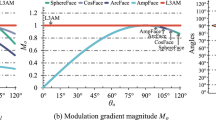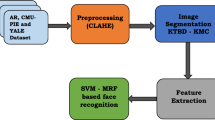Abstract
In this paper, a contactless person verification system based on score level fusion of 2D and 3D finger knuckle patterns. In particular, four types of scores extracted from 3D forefinger FKP (Finger Knuckle Print), 3D middle FKP, 2D forefinger FKP and 2D middle FKP are merged to attain higher accuracy for personal recognition systems. The Tan and Triggs normalization technique (TT) is applied on the depth of 3D FKP image (fore and middle finger) to acquire TT 3D FKP image. Then, a novel and efficient scheme to extract features from TT 3D FKP image, namely Monogenic Local Phase Quantization (MLPQ) is utilized. Also, the MLPQ descriptor is applied on 2D FKP image (fore and middle finger) to extract features. The main idea of MLPQ descriptor is, first, the monogenic filters are applied to decompose TT 3D FKP image or 2D FKP image into three complementary parts: Bandpass, vertical and horizontal Bandpass components. Later, Local Phase Quantization (LPQ) is utilized to encode these complementary components. The encoded components are divided into M × M non-overlapped rectangular sub-regions to calculate their histograms. These histograms sequences are concatenated to build a large feature vector. The kernel fisher analysis (KFA) is used as a dimensionality reduction technique to build the monogenic Local Phase Quantization (MLPQ) feature vector for 3D or 2D FKP recognition. Finally, the cosine distance is used to ascertain the identity of the person. Experimental results using publicly available PolyU FKP dataset show that the presented framework notably attained lower error rates and outperformed the state-of-the-art technique.











Similar content being viewed by others
References
Akhtar Z, Alfarid N (2011) Secure learning algorithm for multimodal biometric systems against spoof attacks. In: Proc. international conference on information and network technology (IPCSIT), pp 52–57
Akhtar Z, Micheloni C, Foresti G (2015) Correlation based fingerprint liveness detection. In: International conference on biometrics (ICB), pp 305–310
Attia A, Akhtar Z, Chalabi NE, Maza S, Chahir Y (2020) Deep rule-based classifier for finger knuckle pattern recognition system. Evolving Systems:1–15. https://doi.org/10.1007/s12530-020-09359-w
Boles A, Rad P (2017) Voice biometrics: deep learning-based voiceprint authentication system. In: 12th system of systems engineering conference (SoSE), pp 1–6. https://doi.org/10.1109/SYSOSE.2017.7994971
Chaa M, Boukezzoula N-E, Meraoumia A (2018) A features-level fusion of reflectance and illumination images in finger-knuckle-print identification system. International Journal on Artificial Intelligence Tools 27:1850007. https://doi.org/10.1142/S0218213018500070
Cheng KH, Kumar A (2019) Contactless biometric identification using 3d finger knuckle patterns. IEEE Trans Pattern Anal Mach Intell:1–1. https://doi.org/10.1109/tpami.2019.2904232
Cheng KH, Kumar A (2020) Deep feature collaboration for challenging 3D finger knuckle identification. IEEE Transactions on Information Forensics and Security 16:1158–1173. https://doi.org/10.1109/TIFS.2020.3029906
Daugman J (2004) How iris recognition works. IEEE Trans Circuits Syst Video 14(1):21–30. https://doi.org/10.1109/TCSVT.2003.818350
Frankot R, Chellappa R (1988) A method for enforcing integrability in shape from shading algorithms. IEEE Trans Pattern Anal Mach Intell 10(4):439–451. https://doi.org/10.1109/34.3909
Fukunaga K (1990) Introduction to statistical pattern recognition, second edn. Academic Press New York
Hong H, Lee M, Park K (2017) Convolutional neural network-based finger-vein recognition using nir image sensors. Sensors (Switzerland) 17(6):1297. https://doi.org/10.3390/s17061297
Hu G, Yang Y, Yi D, Kittler J, Christmas W, Li SZ, Hospedales T (2015) When face recognition meets with deep learning: an evaluation of convolutional neural networks for face recognition. In: Proceedings of the IEEE international conference on computer vision workshops, pp 142–150. https://doi.org/10.1109/ICCVW.2015.58
Jain AK, Flynn P, Ross AA (2008) Handbook of biometrics, vol 556. Springer Science & Business Media X. https://doi.org/10.1007/978-0-387-71041-9
Jea T-Y, Govindaraju V (2005) A minutia-based partial fingerprint recognition system. Pattern Recogn 38(10):1672–1684. https://doi.org/10.1016/j.patcog.2005.03.016
Liu C (2006) Capitalize on dimensionality increasing techniques for improving face recognition grand challenge performance. IEEE Trans Pattern Anal Mach Intell 28(5):725–737. https://doi.org/10.1109/TPAMI.2006.90
Monteiro J, Albuquerque I, Akhtar Z, Falk T (2019) Generalizable adversarial examples detection based on bi-model decision mismatch. In: IEEE International Conference on Systems, Man and Cybernetics (SMC), pp 2839–2844
Morales A, Travieso CM, Ferrer MA, Alonso JB (2011) Improved finger-knuckle-print authentication based on orientation enhancement. Electron Lett 47(6):380–381. https://doi.org/10.1049/el.2011.0156
Ojansivu V, Heikkila J (2008) Blur insensitive texture classification using local phase quantization. In: Proc. ICISP 2008. France, pp 236–243. https://doi.org/10.1007/978-3-540-69905-7_27
Reddy N, Rattani A, Derakhshani R (2020) Generalizable deep features for ocular biometrics. Image Vis Comput 103:103996. https://doi.org/10.1016/j.imavis.2020.103996
Schölkopf B, Smola AJ (2002) Learning with kernels. MIT Press, Cambridge
Shao H, Zhong D, Du X (2019) Efficient deep Palmprint recognition via distilled hashing coding. In: Proceedings of the IEEE/CVF conference on computer vision and pattern recognition workshops (CVPRW), pp 714–723. https://doi.org/10.1109/CVPRW.2019.00098
Simchony T, Chellappa R, Shao M (1990) Direct analytical methods for solving Poisson equations in computer vision problems. IEEE Tran Pattern Anal Mach Intell 12(5):435–446. https://doi.org/10.1109/34.55103
Tan X, Triggs B (2010) Enhanced local texture feature sets for face recognition under difficult lighting conditions. IEEE Trans Image Process 19(6):1635–1650. https://doi.org/10.1109/TIP.2010.2042645
The Hong Kong Polytechnic University Contactless 3D Finger Knuckle Images Database (2019), http://www.comp.polyu.edu.hk/~csajaykr/3DKnuckle.htm
Vidhyapriya R (2019) Personal authentication mechanism based on finger knuckle print. J Med Syst 43:232. https://doi.org/10.1007/s10916-019-1332-3
WANG F, HAN J (2007) Iris recognition method using Log-Gabor filtering and feature fusion. Journal of Xian Jiaotong University 41:889–893
Wang J, Wang G (2017) Quality-specific hand vein recognition system. IEEE Transactions on Information Forensics and Security 12(11):2599–2610. https://doi.org/10.1109/TIFS.2017.2713340
Woodham RJ (1980) Photometric method for determining surface orientation from multiple images. Opt Eng 19(1):139–144. https://doi.org/10.1117/12.7972479
Xie S, Shan S, Chen X, Chen J (2010) Fusing local patterns of Gabor magnitude and phase for face recognition. IEEE Trans Image Process 19:1349–1361. https://doi.org/10.1109/TIP.2010.2041397
Yang M, Zhang L, Zhang L, Zhang D (2010) Monogenic binary pattern (MBP): a novel feature extraction and representation model for face recognition. In ICPR 2010:2680–2683. https://doi.org/10.1109/ICPR.2010.657
Yang M, Zhang L, Shiu SK, Zhang D (2012) Monogenic binary coding: an efficient local feature extraction approach to face recognition. IEEE Transactions on Information Forensics and Security 7(6):1738–1751. https://doi.org/10.1109/TIFS.2012.2217332
Zhang L, Zhang L, Zhang D (2009) Finger-knuckle-print: a new biometric identifier. In: 16th IEEE international conference on image processing (ICIP). IEEE, pp 1981–1984. https://doi.org/10.1109/ICIP.2009.5413734
Zhang L, Zhang L, Zhang D, Zhu H (2010) Online finger-knuckle-print verification for personal authentication. Pattern Recogn 43(7):2560–2571. https://doi.org/10.1016/j.patcog.2010.01.020
Zhang L, Zhang L, Zhang D, Zhu H (2011) Ensemble of local and global information for finger–knuckle print recognition. Pattern Recogn 44(9):1990–1998. https://doi.org/10.1016/j.patcog.2010.06.007
Author information
Authors and Affiliations
Corresponding author
Additional information
Publisher’s note
Springer Nature remains neutral with regard to jurisdictional claims in published maps and institutional affiliations.
Rights and permissions
About this article
Cite this article
Chaa, M., Akhtar, Z. & Lati, A. Contactless person recognition using 2D and 3D finger knuckle patterns. Multimed Tools Appl 81, 8671–8689 (2022). https://doi.org/10.1007/s11042-022-12111-y
Received:
Revised:
Accepted:
Published:
Issue Date:
DOI: https://doi.org/10.1007/s11042-022-12111-y




